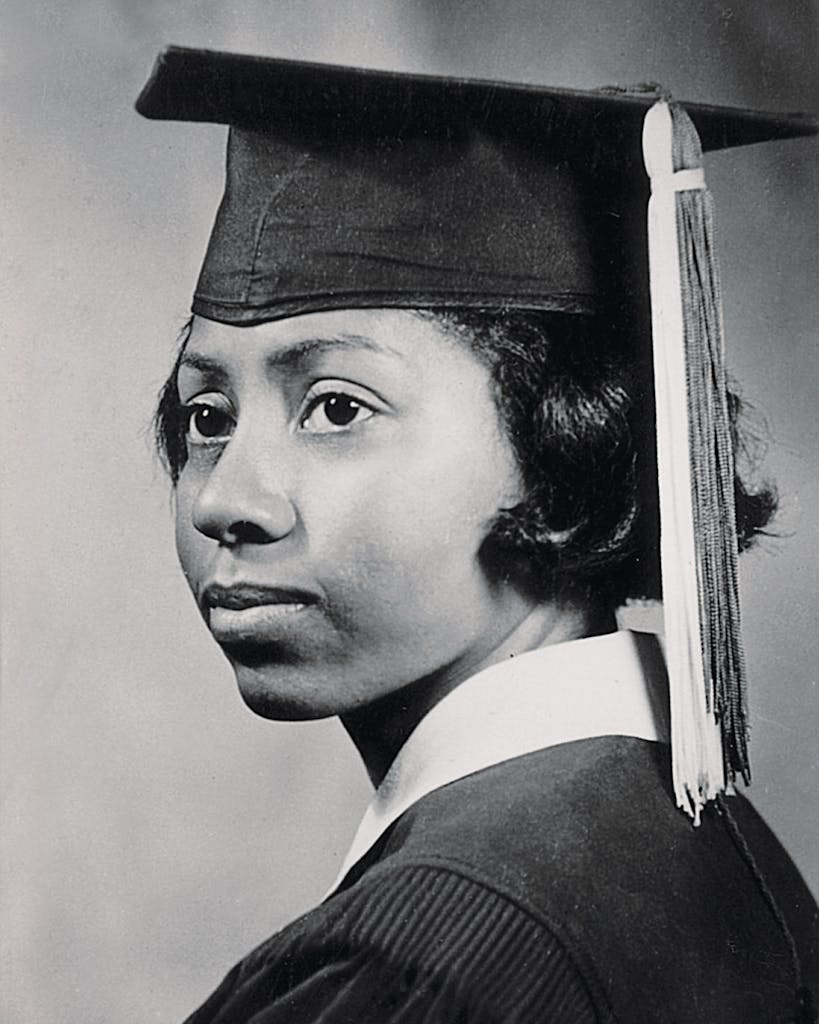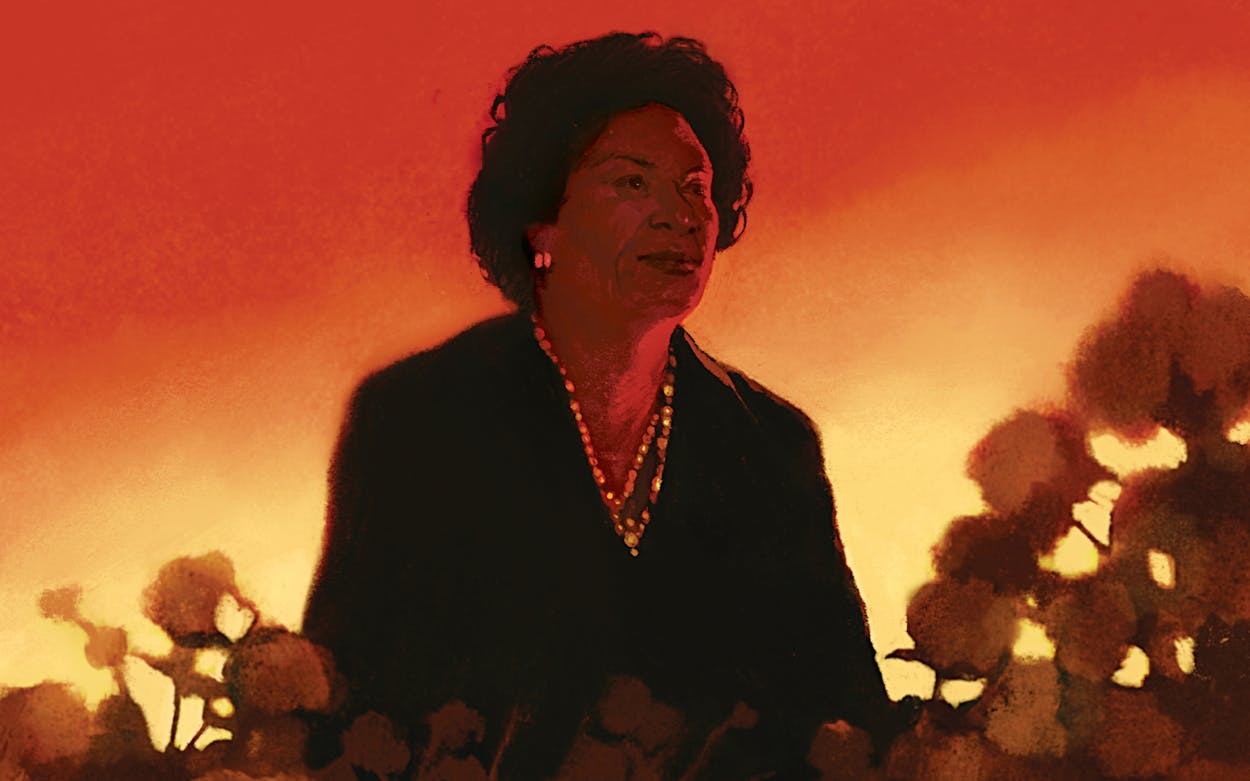On the cover of Ruth J. Simmons’s memoir, Up Home: One Girl’s Journey (Random House), her profile’s silhouette forms the crown of a tall tree. Underneath it, little-girl Ruth sits on a hill, her nose in a book, as she says was often the case during her childhood. It’s an apt illustration for a coming-of-age memoir that details how Simmons, a sharecropper’s daughter, made it out of the East Texas cotton fields and rose to the pinnacle of American higher education.
The first Black president of Smith College, the first Black president of an Ivy League school (Brown University), the first female president of the Houston area’s historically Black college Prairie View A&M University—at each job Simmons raised huge amounts of money and transformed curricula, creating along the way a blueprint for how universities address their historical ties to slavery. There’s a reason Time magazine once called her America’s best university president. Often, media narratives contrast her cosmopolitan present with her segregated past, hinting that she succeeded despite her humble origins. Though Simmons acknowledges in Up Home that her trajectory was somewhat improbable, she also argues that it was, in many ways, her early life that made it possible.
That message shouldn’t be confused with the notion posited by some contemporary education officials and politicians, such as Florida governor Ron DeSantis, that slavery and its brutal aftermath helped the disenfranchised by teaching them “skills” that could be used for their “personal benefit.” Up Home is clear about the stunting effects that systemic racism had on Simmons’s life. “I was born to be someone else,” the prologue begins.
“There were absolutely no opportunities to speak of for people who were Black,” explains the 78-year-old Simmons, who stepped down from her position at Prairie View in February and is now a president’s distinguished fellow at Rice University. Speaking via Zoom from her home office, she recalls the difficulties of her youth. “It was understood that your future was one of menial work, of lack of education, of subservience to what other people dictated in regard to your life. The expectation was that I would follow that path. I saw myself becoming a maid, like other women of that era.”
Up Home reads like an inverse retelling of Richard Wright’s Native Son. That classic 1940 novel casts a young man’s tragic end in the electric chair as the inevitable fate of growing up poor on Chicago’s segregated South Side. Up Home, too, focuses on a childhood steeped in dire poverty and virulent segregation, first in rural East Texas in the forties, then in Houston’s Fifth Ward in the fifties. But thanks to the generosity of loved ones and strangers, some luck, and her own ingenuity, our protagonist eventually finds her way, enrolling in college, studying abroad in Mexico and France, and graduating from Dillard University, a historically Black school in New Orleans. (Though the book’s chronology ends there, Simmons went on to earn master’s and PhD degrees in Romance languages and literatures at Harvard.) While Wright meant his novel to be an indictment of America’s criminally stratified society, Simmons offers her memoir as “a kind of lesson” for her students, she says—instruction by example on how to build “free, happy, meaningful” lives despite continued social barriers.
When Simmons assumed the presidency at Prairie View A&M, in 2017, students dubbed her Ruth the Truth. Simmons thinks the moniker, a riff on the name of the Houston rapper Trae tha Truth, is a nod to her “blunt-spoken” style. “I don’t infantilize them,” she says of her interactions with students. “I say what I think without hedging, generally.”

Simmons brought much more than rhetorical style to the campus. Melanye Price, a Prairie View alumna who is now an endowed professor of political science and the director of the school’s Ruth J. Simmons Center for Race and Justice, says, “She put her money, her Rolodex, her time, her name—she gave Prairie View all of that.” The $50 million that novelist and philanthropist MacKenzie Scott donated three years ago increased the school’s endowment by 40 percent overnight. “I’ve seen people practically genuflect in her presence,” Price says of Simmons. “Like, damn near curtsy.”
Like its author, Up Home is endearingly candid. Students may be surprised, for instance, to learn that Ruth the Truth was once a “pretentious brat” who, as a teenager, adopted an affected style of speech and the theatrical airs to match. She unilaterally changed her name, adding an “e” to her first name and “ne” to her middle name: Ruth Jean became Ruthe Jeanne. Everyone else became “ ‘Dahhh . . . ling.’ ”
“I was an idiot,” she insists now, amused by the tender memory of the girl who, ridiculed by her better-off schoolmates for her country ways, mistook exaggerated elocution and multisyllabic words for personal worth. “It’s very hard, when you sit down to write a book about your life, to prevent yourself from painting a beautiful picture. And I didn’t want to do that. I wanted to paint an honest portrait of what I’ve lived through.”
Born Ruth Jean Stubblefield outside Grapeland, in north Houston County, Simmons had “no sentimental attachment” to the East Texas landscape as a child. It’s no wonder. The youngest of twelve children, she spent her early years on the Murray Farm, a 4,500-acre plantation where her family worked cotton crops to eke out a subsistence living. They lived in a tin-covered shanty, ate “phantom meals” of biscuits drizzled with syrup and bacon fat, and wore empty cotton sacks that had been repurposed as dresses. Racial violence was required to enforce such subjugation, so “encounters with whites often meant danger” and humiliation.
To avoid being consumed by these hostile circumstances, Simmons writes, she learned to imagine “far different worlds,” a lifelong practice that first began amid the verdant fields of East Texas. Its tall red oaks and intersecting creeks enticed her to explore what lay beyond the rows of cotton. When not doing chores, she’d roam the clay roads, mostly barefoot, curious to see what she could see—mainly farm animals and the grape fields for which the area is known. (To this day, she still returns “up home” every chance she gets, as a reminder, she writes, of what she learned there.)
Simmons crossed the color line that circumscribed her ambitions when she befriended a white girl whose family were also sharecroppers. The two played together for days on end, running in and out of each other’s houses. “I was surrounded by hatred, but along comes this person who turns out to be my best friend,” she says. “That’s what students need to be focused on, [not hatred, but] making connections with people of different backgrounds and building a different future for themselves and their children.”
A formal education provided “the key to the realm” Simmons had begun to imagine. In a sharecropping family, most children attended school only if there was no work on the farm. Fortunately, as she neared school age, her family moved to Houston, where school attendance was more strictly enforced. Teacher after gifted Black teacher affirmed her intelligence, beauty, and worth. And the literature she encountered in their classrooms—Anne of Green Gables, Antigone, Ivanhoe, Little Women—helped her see a way forward. She collected words the way other children collect dolls or baseball cards, “wanting to learn specific ways language could open doors to unfamiliar worlds” and overcome the powerlessness of poverty.
Those same books became a solace when her mother died, a week before Simmons’s sixteenth birthday. A modest homemaker who cleaned houses and occasionally took in ironing to make ends meet, Fannie Campbell Stubblefield executed the smallest task with the utmost dignity, serving as the model for Simmons’s career. Losing that compass so young left Simmons adrift. “I came undone,” she says. But she turned to reading novels—“anything that would help me escape the present”—and discovered the healing value of the arts.

“When people are in the midst of something perilous or disappointing, our mind is a big part of how we recover. As an educator, I want people to appreciate what the ideas we put in our minds can do for us over a span of a life, whether it’s gaining solace from a certain artist or recalling philosophical or religious texts or a beautiful narrative, like [Toni Morrison’s] Song of Solomon. We have all these things that we can call upon.”
Beyond knowledge and solace, the humanities also “help you define who you are in the context of history,” Simmons says. Recently, she believes, things have taken a downturn for many of her students: the Supreme Court ended affirmative action in college admissions and Texas joined Florida in passing legislation that strictly curtails diversity, equity, and inclusion programs at public universities. At the Texas A&M system (which Simmons left earlier than expected after a dispute over presidential powers), political interference in hiring and the controversial suspension of a professor have raised concerns about academic freedom and governance.
Yet Simmons remains hopeful. “We have to remember that these are singular acts; they are not immutable,” she says. She encourages readers to not focus on “the worst impulses, the worst actions, the worst politics, privileging them as if they will always be there. They won’t be.” As she says, and proves by example in Up Home, “Every day we shape who we are and the future by virtue of our own actions.”
Dallas native Angela Ards is a journalist and an associate professor of English at Boston College.
This article originally appeared in the October 2023 issue of Texas Monthly with the headline “Native Daughter.” Subscribe today.
- More About:
- Books
- Rice University
- Higher Education
- Houston







